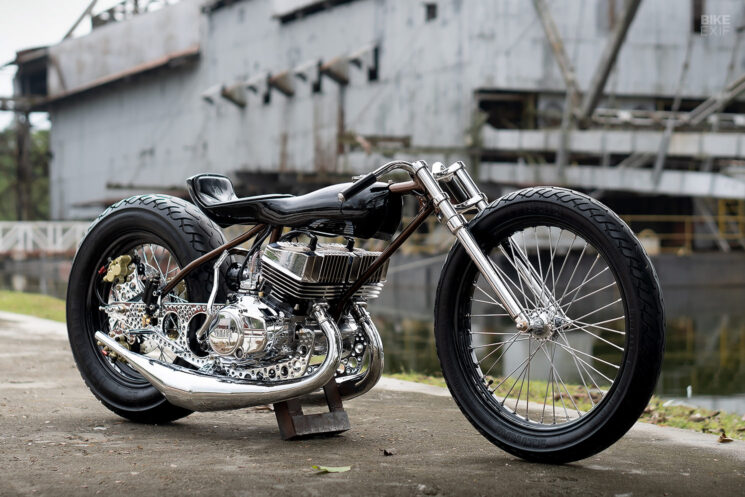
Remember the Yamaha RXZ Twinboss twin-cylinder two-stroke? Neither do we, because it never existed—except in the mind of Irwann Cheng.
The Malaysian custom builder, who operates as FNG Works, has masterfully combined two Yamaha RXZ 135 engines with such panache, that you’d be forgiven for mistaking this for a factory unit. But what impresses us most about this scratch-built dragster is not its bespoke powerplant—nor its handmade chassis or eerily perfect proportions. What makes it special, is the epic journey that Irwann took to bring it to life.
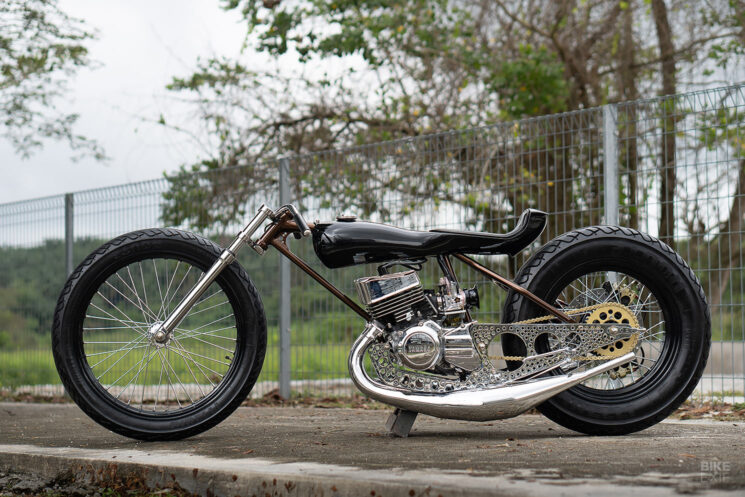
The seed was planted six years ago when another custom shop asked Irwann to help them finish their build in time for the prestigious Yokohama Hot Rod Custom Show in Japan. As a thank you, they bought Irwann a plane ticket to accompany the bike to the show. Having just completed his mechanical engineering degree, his mind was blown.
“I was really, really amazed by the bikes I saw there,” he tells us. “The engineering, the complexity, the fabrication level, the design. It was at that moment that I decided that this is what I wanted to do with my life, and that I had to come back here again, with my own bike, to showcase it to the world.”
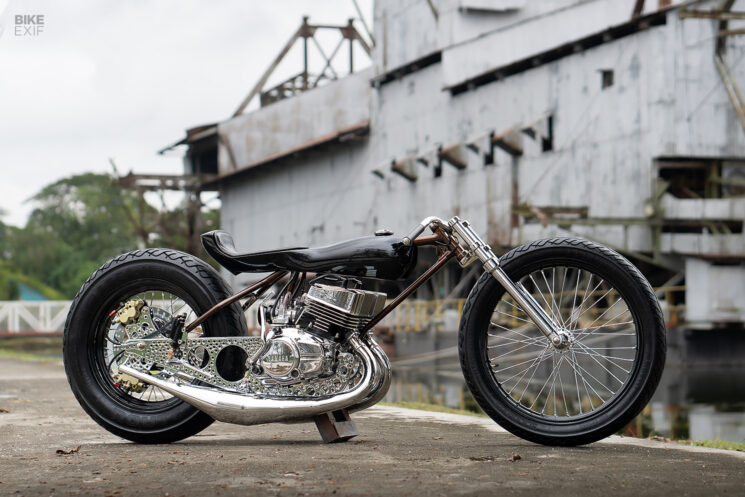
Returning to the Mooneyes show became an obsession. “I followed the show every year from the website and social media channels. I studied the bikes that won awards, the bikes that didn’t, the workshops that won before but not in that year, and the workshops that didn’t win before, but did win that year.”
An opportunity arose when Malaysia’s biggest custom show, Art of Speed, hosted a build-off invitational with a killer prize—a sponsored trip to show their bike off at Mooneyes. No sooner had Irwann scraped together all of his savings to kick-start a suitable project, than the COVID-19 pandemic shut everything down.
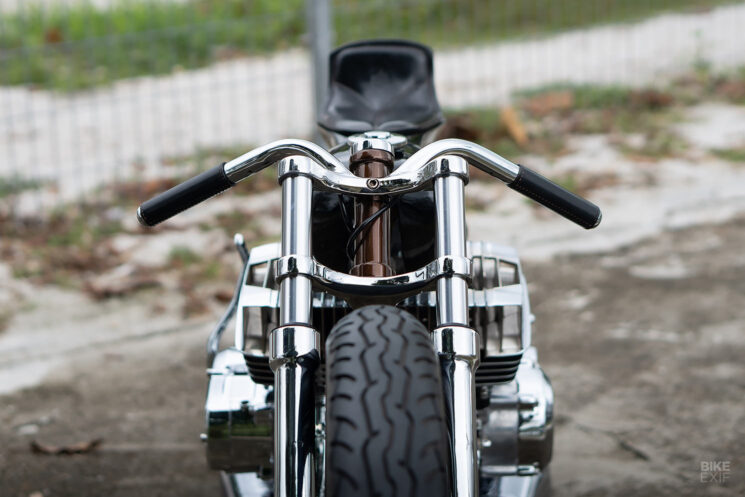
It was only at the end of last year that Art of Speed finally rebooted the build-off. “This time, due to the lockdowns and retrenchment, I was in a worse financial position than I was last time,” Irwann tells us. But I was committed.”
“I figured that this was the only chance I would have in my lifetime to pursue this dream. I sold almost all of my belongings and took a personal loan from the bank to restart the project.”
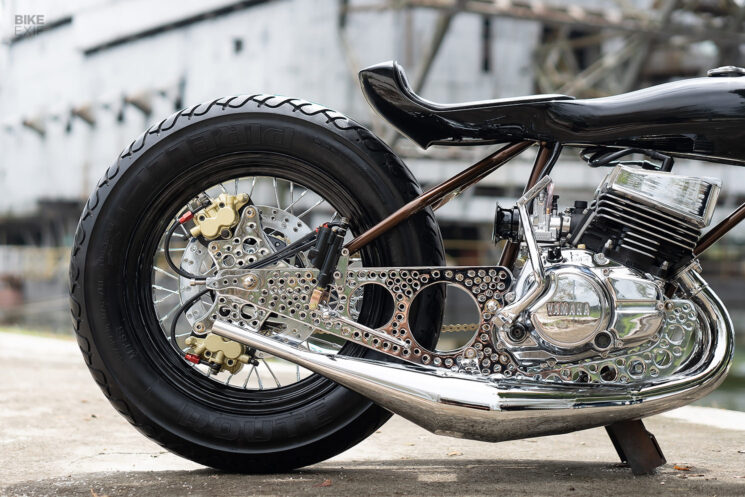
Given how dedicated Irwann was to the project, going all-in was the only option. But before putting grinder to metal, he first nerded out on every aspect of the design. “I tried to incorporate my shallow knowledge of motorcycle proportions; the golden ratio, Fibonacci spiral, synergy of lines, etcetera.”
“For example, the distance between the front edge of the rear wheel to the rear edge of the front wheel, is the same as the distance from the center of the rear wheel to the front of the engine, the total height of the bike, and the length of the tank-seat unit. That number, multiplied by 1.618, is the same as the length from the front edge of the rear wheel to the center of the front wheel.”
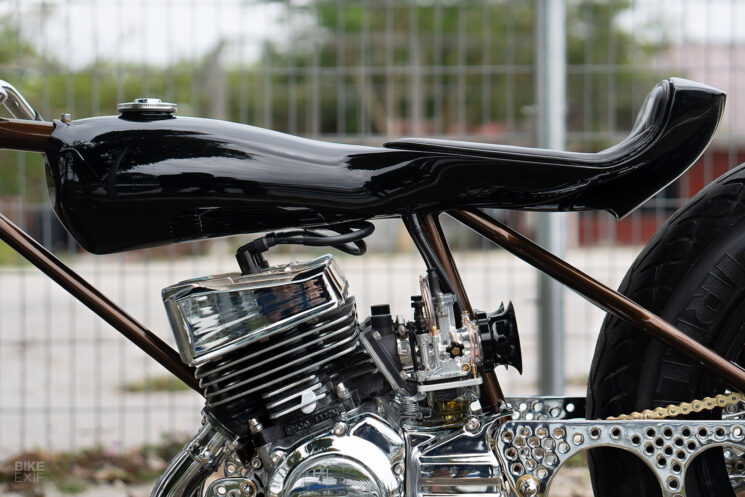
Starting with the chassis, Irwann mated sections of tubing to a pair of steel plates that also act as engine mounts. The plates were cut using an angle grinder and drilled by hand, drawing inspiration from Kiyo’s Garage’s nutty triple-engined land speeder.
The frame’s design features more parallel lines than you can shake a stick at. Some are obvious, but others are far more subtle—like the way the exhaust flanges match the angle of the frame’s main downtube, and how the top and bottom edges of the chain line up with the opposite edges of the frame plates.
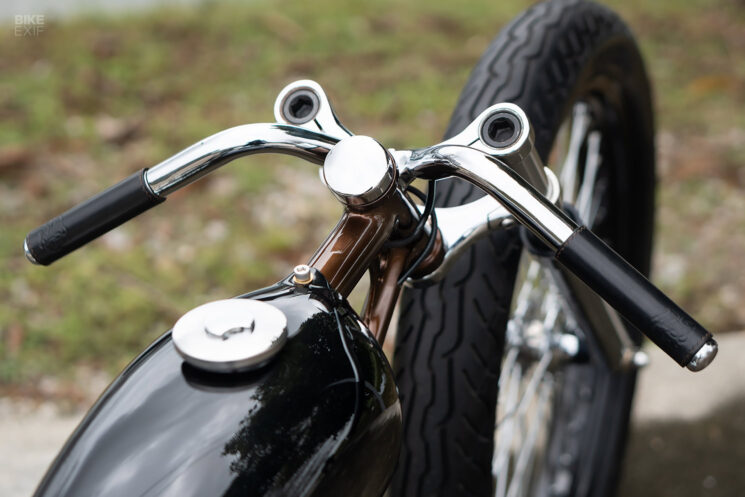
A set of Yamaha RXZ forks, supplied by Taikom Racing, offer the only bit of suspension on the bike. Irwann liberated them of their brake and fender mounts, then cleaned up the lowers until they were perfectly tubular. The forks are held in place by a pair of custom yokes with a very interesting design.
The bottom yoke sits where you’d expect it to, but the top yoke links up with the steering stem through a cut-out in the frame’s neck. Irwann built it this way so that the frame’s top tube would trace a line directly from the top yoke to the top of the rear tire.
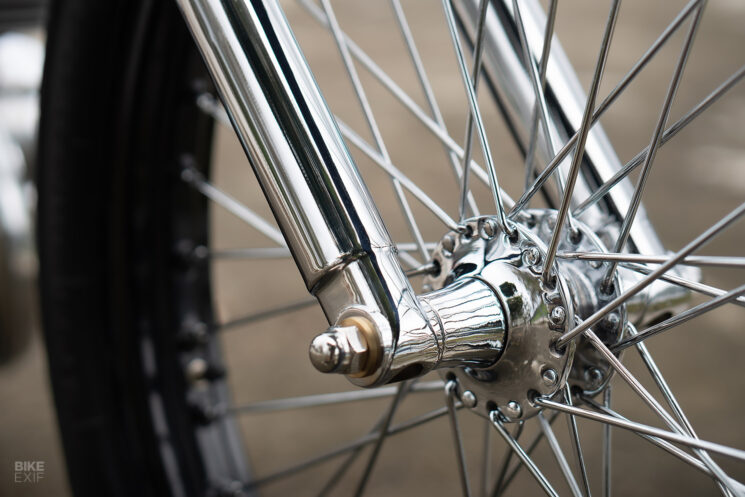
To cut costs, Irwann pieced the wheels together from as many upcycled parts as possible. The 19” front rim and Pirelli tires were leftover from previous projects, and the front hub is a modified racing moped part. Irwann removed its brake disc mounts and machined it to look more like a bicycle hub.
For the rear wheel, he took a car’s spare and cut out the center, so that he could lace it to a disc brake hub. Two Yamaha Y125Z calipers provide a modicum of stopping power.
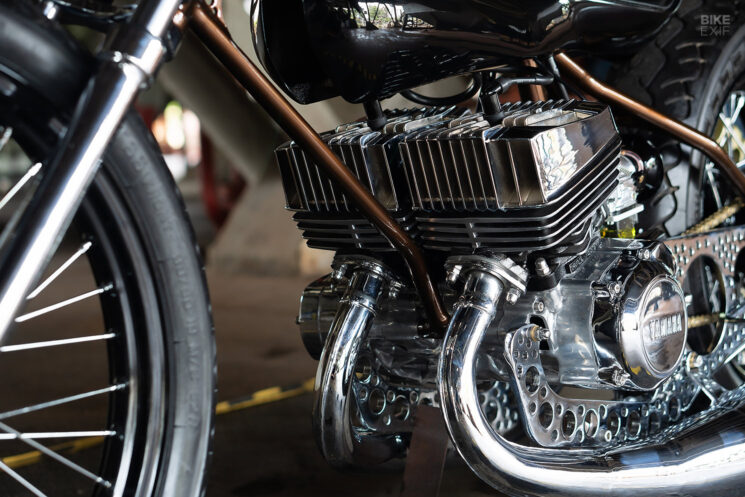
And then there’s the bike’s unique twin-cylinder motor—a combination of two first-generation Yamaha RXZ 125 units. “Figuring that this bike could be representing Malaysia in Japan, I chose the Yamaha RXZ 135 engine as a base. I can honestly say that the Yamaha RXZ is the most popular bike in Malaysia; it has a cult-like following.”
Irwann has built a twin-engined Yamaha RXZ before—but that bike had one motor placed in front of the other. This time around, he put them side-by-side, effectively creating an inline 180-degree twin. And since first-gen RXZ was officially titled the ‘Boss,’ he named his creation the ‘Twinboss.’
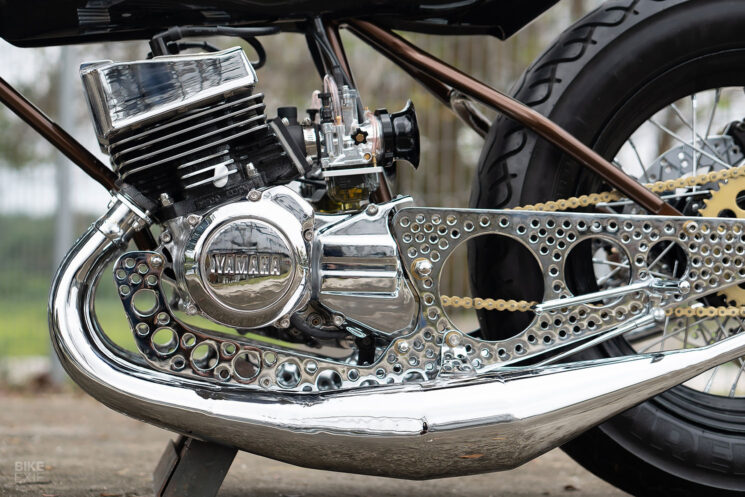
On the inside, the two individual crankshafts were modified to work as a male-female couple. On the outside, the cases were split and then welded together, then massaged until the whole arrangement looked like it had rolled straight out of Yamaha’s factory. “Even the judges at Art of Speed weren’t impressed by the engine at first (because they thought it was stock),” says Irwann, “until I told them that it was originally a single-cylinder engine and showed them the photos of the modification process.”
“I got lucky, as Taikom Racing and UMA Racing chipped in to supply their parts to me—it was a big financial relief. 80 percent of the engine internals were from Taikom Racing, including the cylinder blocks, engine studs and bolts, oil seals, gaskets, reed valves, bearings, clutch assembly, stator coils, and CDI. UMA Racing provided the carburetors, ignition coils, and engine oil.”

Most of the bike’s finishing kit is custom too. The exhaust system uses RXZ headers, with handmade chambers and mufflers. The handlebars are an old set that was modified and welded directly to the top yoke, before being fitted with internal throttle and clutch controls. Irwann fabricated the foot controls too, intentionally keeping them as minimalist as possible.
Moving to the bodywork, Irwann wanted an organic one-piece unit that would “look sexy and have curves.” His friend at LNS Motor sponsored the paint job; Chameleon Brown for the frame, and black with a subtle sparkle for the body. Azwan from Kedaung Leather Work finished the Yamaha off with vegetable-tanned buffalo leather touches on the seat and grips.
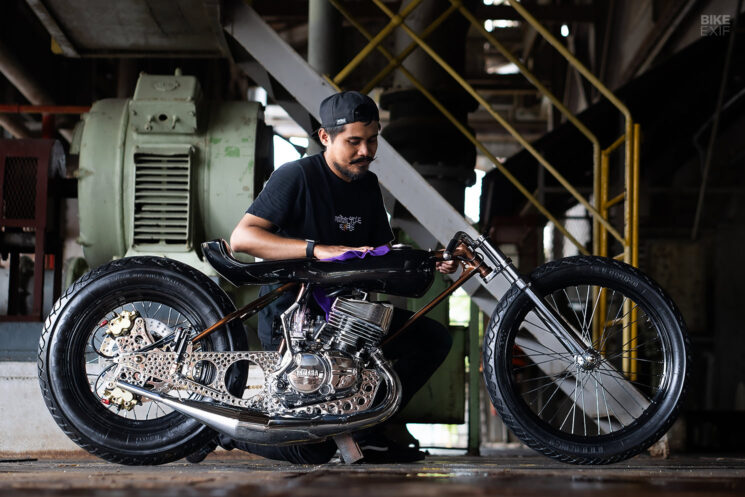
Working only after normal work hours and operating on the narrowest of budgets, Irwann threw everything at his Yamaha RXZ Twinboss. But when the Art of Speed show rolled around, it all paid off. Irwann took home the gold, securing his place at this year’s Mooneyes show.
“Even though people know FNG Works as a one-man show, a lot of people were involved in this build—especially emotionally, since they know my story, struggles, and sacrifices.”
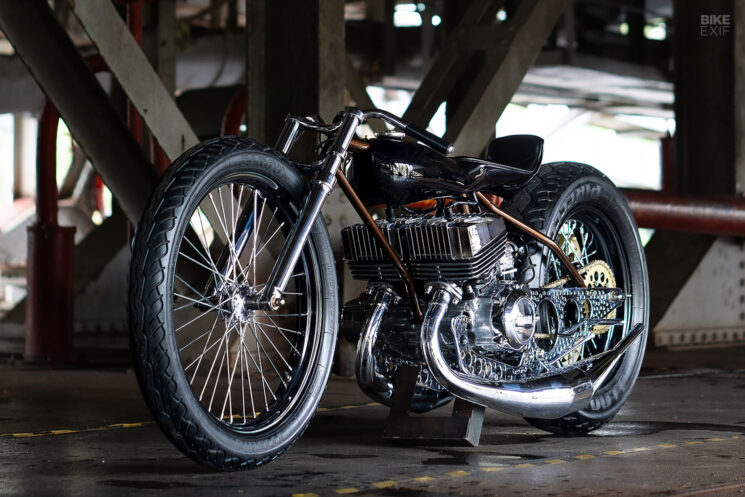
“A lot of people shed tears when I was announced as a winner. I hope this bike will bring joy to more people when it’s shown at the Yokohama Hot Rod Custom Show this December.”
Bravo, Irwann.
FNG Works Instagram | Facebook | Images by Amin Hamid
Irwann would like to thank Taikom Racing, UMA Racing, LNS Motor, Kedaung Leather Work, Afiat Cap Gambus, Riders Garage, Bagiruang, Decibel Store, and all the friends that chipped in to help him finish this project.
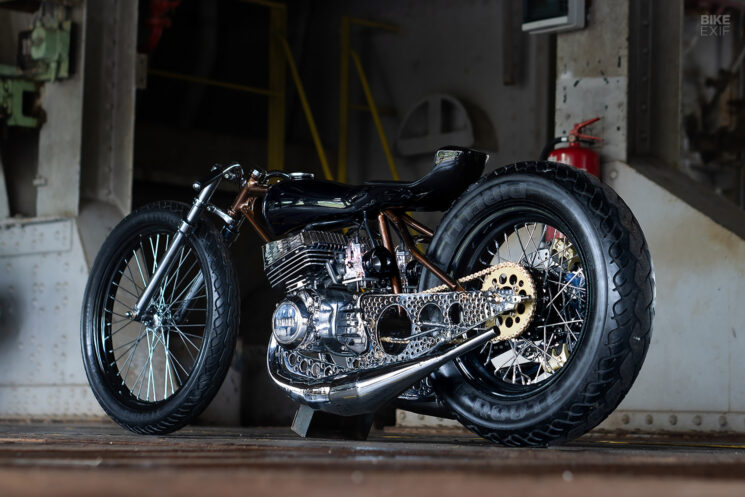
from Bike EXIF https://ift.tt/7wYv4sH
No comments:
Post a Comment